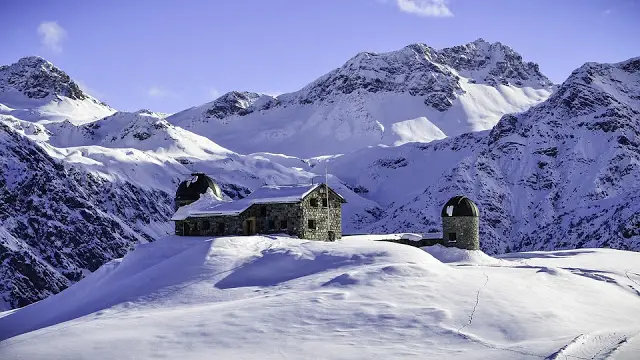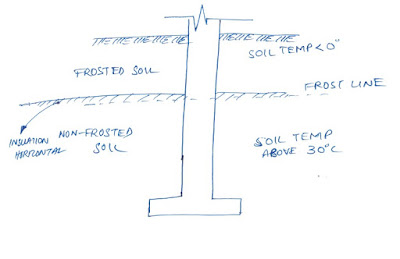Building houses and structures in extreme climates is always a challenge, the temperature depending characteristics of building materials is the sole reason for such a trial. Concrete pouring in hot expands too much and in cold climate contracts too much thereby producing such internal stresses that if not properly taken under-consideration would produce extreme internal strains that might be havoc for the structural integrity and serviceability of the structure.
 |
| What is Frost Wall? Purpose & Types |
In this post today we will talk about the condition of the soil in freezing weathers and its adverse effect in the form of frost heave and its solution in the form of frost wall.
Reason why Frost Wall is needed?
From soil mechanics, it is a well known fact that the matrix of soil particles has voids and gaps that are partially filled by air and water for non-saturated soils. For dry soil (oven dry) the voids are only filled with air while for saturated soils the voids are completely filled by water. Mostly the soil underneath the foundation of the building is soil with partially filled voids by water. This water, during extreme cold climates when the outside temperature falls, freezes and thus producing frost heave.
Frost heave expands as the ice in the soil accumulates in a structure called ice lens and as we know by the behavior of water; the volume of water increases as it is converted to ice. Thereby, due to conversion and growth of water to ice lens in the soil voids, they push the nearby surrounding soil. The structures having foundation resting on such soils will be shoved upward and thus damaged by the action of ice. The stress reversal occurs after suitable increase in climate and thus thawing might occur relieving the upward shoving of the structure.
The only remedy for this problem exists in preventing the freezing and heaving of the underneath soil of the foundation. The reason we don’t want the ground to freeze is that frozen ground moves and thus moving the concrete walls up and down.
What is Frost Wall?
Frost walls are actually insulating walls that are constructed / placed deep in the ground around the periphery of the foundations beneath the frost line; so that in the cold winters when the ground freezes the walls and the footings are sitting on will not end up with the ground freezing underneath them.
Sometimes the term frost wall is also referred to the walls placed above ground inside the house for insulation. And sometimes it is also referred to an insulating layer / frost protection of soil placed between house foundation and a wall constructed sufficiently gapped. This type of frost wall only worked for heated structures. This type of frost wall holds heat from the structure in the ground to prevent freezing in areas where ground frost is common.
The frost wall may be load bearing or non-load bearing; in case of load bearing wall the frost wall itself is a foundation wall that takes the foundation deep enough which is below the frost line of that area. In case of non-load-bearing wall it is just an insulating barrio as explained above. The basements in many older homes are not insulated and, therefore, require a frost wall built just inside the basement’s exterior walls to reduce heat loss through the foundation. The interior wall should not touch the exterior wall, and should include a moisture barrier to prevent moist interior air from forming ice inside the wall.
Before the frost wall is fully functional, in case of a basement beneath the building, some preparatory works needs to be done for an effective heat-loss-control phenomenon. For example, basement walls that are made from cinder blocks require the homeowner to patch any open gaps in the mortar with brick filler. Basement walls that are made from poured concrete require the homeowner to patch any cracks with concrete sealer. Once the concrete sealer is applied, the next step is to apply a paint sealer, specialty paint that helps prevent moisture from entering the basement. This is extremely important because the formation of moisture between the frost wall and the basement wall promotes mold growth.
Types of Frost Walls
Protecting Shallow Foundation with Frost-Protection Insulating
This type of frost wall is non-load-bearing wall and is meant to protect a building with shallow foundation when deep foundation is not-economical or not-feasible. The wall constructed after leaving a sufficient gap with the building foundation would prevent the soil from losing heat. In such a type of frost wall, the soil surround a building’s foundation would warm up by the heat that is radiated from the building.
 |
|
Protecting Shallow Foundation with Frost-Protection Insulating |
A layer of rigid foam insulation is applied vertically to the outside of the foundation wall, and another layer of rigid insulation is placed horizontally under the soil at the base of the foundation wall. These layers of insulation direct the warmth from the heated interior of the building downward into the soil and keep it there so that the soil does not freeze.
Frost-protection wall for non-heated Buildings
Frost wall of type 1 explained above is only applied for a heated building as in such a frost-protected wall the warmth radiated by building is the only source of heat. But for unheated buildings such a type of frost wall will not work.
 |
|
Frost-protection wall for non-heated Buildings |
An alternative design would be to use the heat of the temperature of deeper layers of earth which is always around 40 to 50 degrees throughout the year. In this design, a horizontal layer of insulation is laid under the building\’s entire foundation and extends outward from the foundation, but there is no vertical insulation.
The layer of insulation rests on a layer of gravel. The warmth of the soil is stored and radiated upward, preventing the upper layers of soil from freezing.
Cost
Although for the cost, it depends on the design, but usually it is not an expensive structure and keeping the long-term benefits in view the economy is not the decisive factor whether to build it or not. Usually they are a 4 ft high concrete wall sitting on a footing. Usually they do not require water proofing or structural steel, this is because they are back-filled on each side in your walkout basement.




















